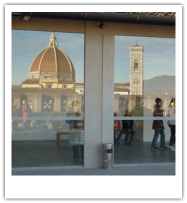 I'M USUALLY quite forgiving of people who are patriotic or nationalistic. It amuses me, but I know that I am probably just as guilty, especially in those more trying moments of life in a foreign country. We take comfort in thinking that we are part of a greater group of achievers and achievements. There is of course an ugly side to patriotism. Its the blind rabbidism that is based on half truths, assumptions and plain rubbish and I unfortunately encounter it here on a regular basis. An example here in Italy is of how Italians perceive their country. True, recent decades haven't been very kind to Italy. They have been caught up in a vicious cycle of politics, stagnation and economic woes and now, with a technocratic government in place are paying the price by means of an endless stream of new taxes and an annhilation of worker's rights in an attempt to modernise the economy. So, when Italians tell me that Italy is home to more than 70% (90% on occassion) of the world's patromonio, that is, cultural heritage, I bite my tongue and let them continue believing it. I mean, everybody is at them and on their case about everything that it seems really petty for me to correct them. What they are referring to infact is the UNESCO World Heritage listing. But maths is probably not a strong point in this country. It is true that Italy has more sites on the respective lists than any other country, and that like any other person who dabbles in a bit of nationalism, they deserve to be proud of their heritage, but, its not the one horse race some Italians would have you believe. Italy, by the latest count, has 44 sites listed for their cultural significance. That's six more than Spain (38) and eleven more than both Germany and France's total of 33. Overall, on the combined list of natural and cultural sites, Italy comes in trumps again with 47, with Spain close behind with 43 and China with 41. These are impressive numbers. There is an entirely other debate to be had about the UNESCO listings, but its important to also consider that there are approxiamately 725 sites around the world that have qualified for status. Italians who cling to this idea that their cultural heritage is the centre of the universe probably could do with a cup of tea and a few deep breaths before being made aware of this. Click on READ MORE to continue the post. The bigger issue is not the gulf between the perceived figures and the reality, but instead the disparity between the status being appointed to these places and structures and the subsequent management of the sites.
Yes, Italy has a very strong showing in the UNESCO listings, but, much of its Roman heritage at least is crumbling. Literally. Pompeii in particular has had its troubles well documented in recent months. Years of mismanagement and economic troubles have compounded the deterioration of this and other sites. Elsewhere, the ministry for culture here generally is last in line for government funding. In these times of economic woe, fiscal policy makers argue that art is not going to put food on the table. But, that's not entirely true, and not the point. The world renowned Riace statues are enclosed in a museum that has not been able to permit entry to visitors for the last two years because they can't afford to keep the doors open nor to pay their staff. The economic stimulus the site could offer to the economically depressed region of Calabria would put some food on the table. People come to Italy to sample its culinary culture, to consume its fashion and design, to see its legacy of visual arts that are imprinted in our subconscious, to be seduced by its charming and sexy locals and to visit its sites. In the 1990s visitors to Europe were often left disappointed by the amount of scaffolding that shrouded some of the world's most recogniseable landmarks in an attempt to combat the effects of acid rain, pollution and decades of smog. Now, its not so much the effects of modern machinery and climate change that threaten the legacy, but economic factors which are rendering world reknown sites into ruins and curtailing the Italian experience. Attaining UNESCO status requires some kind of obligation on the part of locals and governments to maintain and protect the qualities that led to the honors in the first place. Unfortunately here at least, money is so tight that it is not seen as a priority of any sort. Private funding, as recently played out with Tod's offer to finance the latest restoration of the Colosseum (another site that is literally falling apart) can be problematic and engenders major resentment. A recent court case suggested that Tod's circumnavigated the legal requirements of the tender process (the case was dismissed). For a nation which still desperately relies in part on tourism, it seems we are in the midst of yet another vicious cycle that shows no sign of being broken any time soon. But Italy's treasures have never faced greater risks.
2 Comments
interesting view, even tough i would consider few other things, not least france and spain are almost double big in terms of km2 compared to italy. I'm not trying to defend our lazyness and total lack of respect for our territory and heritage, but it is more complicated than it seems. calabria for example dont care about riaces, you know why? people keep going there, for the sea, every year, there is more than those beautiful important statues, than as we dont respect a worldwide heritage, something which not ours but everyone's we just forget about it. but still, I think it would really complicated and hard to handle for every culture or nation in the world. plus, if you compare italy and let's say spain list? well look how many hystorical city centers are there in the list. I think it's slightly different can we compare just for a second let's say toledo and naples? [same font english wikipedia]
Reply
10/8/2012 01:41:52 am
Great post about this. I am sure many visitors will find this very useful. Thank you for sharing...........
Reply
Your comment will be posted after it is approved.
Leave a Reply. |
Dave
|
|
|
Dave Di Vito is a writer, teacher and former curator.He's also the author of the Vinyl Tiger series and Replace The Sky.
For information about upcoming writing projects subscribe to the mailing list. Dave hates SPAM so he won't trouble you with any of his own. He promises. |




 RSS Feed
RSS Feed